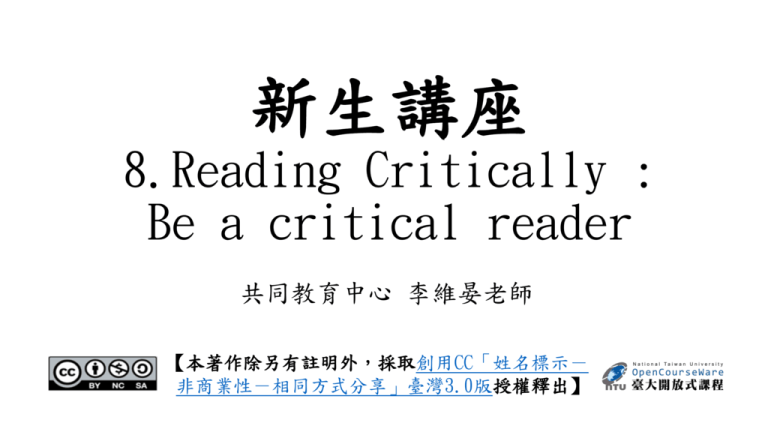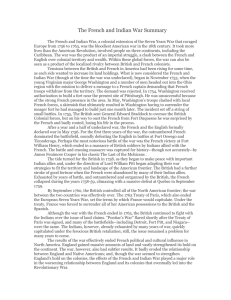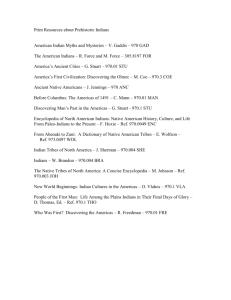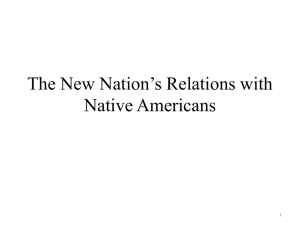
新生講座
8.Reading Critically :
Be a critical reader
共同教育中心 李維晏老師
【本著作除另有註明外,採取創用CC「姓名標示-
非商業性-相同方式分享」臺灣3.0版授權釋出】
Critical Thinking
• Problem Identified Hypothesis
Formulated Data Gathered
Hypothesis Tested Conclusion Drawn
• Ask appropriate questions Gather
relevant information Efficiently
Process information Logically
reason relationships Draw reliable
conclusions/ generalizations
2
2
Critical Thinking & Critical Reading
• Ask appropriate questions
• Gather relevant information
• Efficiently Process information
• Logically reason relationships
• Draw reliable conclusions/ generalizations
“Children must be taught how to think, not what to think.”
~Margaret Mead~
3
3
Sample Reading
Things NOT to Say to American Indian Coworkers
a.
b.
c.
d.
Hey, Chief.
What’s your favorite movie?
How old are you?
Have you gained some weight recently?
4
Sample Reading
Things NOT to Say to American Indian Coworkers
Questions :
What Why Who Where When How
5
Sample Reading
Things NOT to Say to American Indian Coworkers
1. How Indian are you?
2. Hey, Chief.
3. Squaw.
4. Hold down the fort.
5. Don’t you get everything for free?
6. Do you live in a teepee?
7. That’s a nice costume.
8. I’m part Cherokee.
9. Indian-giver.
10. You guys just need to stop living in the past!
Ref. [3] [4] [5]
6
Sample Reading
Things NOT to Say to American Indian Coworkers
Hold down the fort
In a general context, “hold down the fort” simply
refers to leaving someone in charge. But when said in
reference to American Indians, it may be interpreted to
mean “watch out for the Indians.” “Historically, forts in
America were built to hold back the Indians,” says Waters,
“this implies that Indians are always on the ‘war path.’”
Ref. [3]
7
Squaw
While there are different opinions as to the exact
meaning and origin of the word “squaw,” that doesn’t
give you free license to use it with American Indians,
male or female. The word is believed to have come from
the Algonquian Indian term for “woman,” but it began
taking on derogatory meanings as early as the 19th
century, and many now see it as a reference to a
woman’s sexual organs. “Squaw, with most Indian males
and females, is offensive,” says Waters.
Ref. [3]
8
Reading Strategies & Procedures
Skimming 1:
(1)Read the title, sub-titles
(2)Guess the main ideas
Things NOT to Say to American Indian Coworkers
a.
b.
c.
d.
Hey, Chief.
What’s your favorite movie?
How old are you?
Have you gained some weight recently?
9
Skimming 1:
(3) Read the guiding questions
(4) Make predictions
Questions :
What Why Who Where When How
10
Reading Strategies & Procedures
1. How Indian are you?
Skimming 2 :
2. Hey, Chief.
(1)Read the 1st & 2nd sentences
and the last sentence of
3. Squaw.
each mini-section.
(2)Confirm the main idea(s)
4. Hold down the fort.
(3)Identify questions/ problems
5. Don’t you get everything for free?
6. Do you live in a teepee?
7. That’s a nice costume.
8. I’m part Cherokee.
9. Indian-giver.
10. You guys just need to stop living in the past!
Ref. [3] [4] [5]
11
Reading Strategies & Procedures
Scanning:
(1)Read carefully.
(2)Answer the Wh- Qs.
Hold down the fort
In a general context, “hold down the fort” simply
refers to leaving someone in charge. But when said in
reference to American Indians, it may be interpreted to
mean “watch out for the Indians.” “Historically, forts in
America were built to hold back the Indians,” says Waters,
“this implies that Indians are always on the ‘war path.’”
Ref. [3]
12
Reading Strategies & Procedures
Inferring:
(1)Associate details.
(2)Recover the meaning
from context.
Squaw
While there are different opinions as to the exact
meaning and origin of the word “squaw,” that doesn’t
give you free license to use it with American Indians,
male or female. The word is believed to have come from
the Algonquian Indian term for “woman,” but it began
taking on derogatory meanings as early as the 19th
century, and many now see it as a reference to a
woman’s sexual organs. “Squaw, with most Indian males
and females, is offensive,” says Waters.
Ref. [3]
13
Reading Strategies & Procedures
Things NOT to Say to American Indian Coworkers
1. How Indian are you?
2. Hey, Chief.
3. Squaw.
4. Hold down the fort.
5. Don’t you get everything for free?
6. Do you live in a teepee?
7. That’s a nice costume.
8. I’m part Cherokee.
9. Indian-giver.
10. You guys just need to stop living in the past!
Summarizing &
Note-Taking
Ref. [3] [4] [5]
14
Critical Reading
Reading
• Passive-ness
• Comprehension
• Extension
Critical Reading
• Active-ness
• Investigation
• Reflection
15
Be a Critical Reader
Onion Peeling Concept
Biased、Distorted、Prejudiced
Objectivity、Integrity
Fair-mindedness
Ref. [6]
16
Factor 1: Knowledge
Factor 2: Ability
http://en.wikipedia.org/wiki/File:Spinning_Dancer.gif
17
Factor 3: Personal Backgrounds
• Video : Selective attention test
• Daniel Simons and Christopher Chabris (1999)
Ref. [7]
18
Factor 4:
The Completeness of the material
• Video : Guardian TV Ad Newspapers Point Of View Skinhead
19
Sample Reading
Things NOT to Say to American Indian Coworkers
1. How Indian are you?
2. Hey, Chief.
3. Squaw.
4. Hold down the fort.
5. Don’t you get everything for free?
6. Do you live in a teepee?
7. That’s a nice costume.
8. I’m part Cherokee.
9. Indian-giver.
10. You guys just need to stop living in the past!
20
Useful Information & HW
Being a critical individual:
Find 3 useful resources for training reading skills.
Share your findings.
Useful resources will be introduced by the teacher
next week.
21
Study Hard, Play Harder!
USEFUL RESOURCE
Edward M. Glaser (1941). An Experiment in the Development of Critical Thinking. New York, Bureau of
Publications, Teachers College, Columbia University.ISBN 0-404-55843-7.
Reynolds, Martin. (2011). Critical thinking and systems thinking: towards a critical literacy for systems
thinking in practice“, p. 37-68.
Facione, PA. (2011). “Critical Thinking: What It is and Why it Counts”.
22
版權聲明
頁碼
作品
版權標示
來源/作者
wikicommons/LadyofHats
http://commons.wikimedia.org/wiki/File:Newton_portrait_with_apple_tree.svg
本著作以創用CC0釋出,屬於公眾領域作品。
2
3
“Children must
be taught how to
think, not what
to think.”
Goodreads/Margaret Mead (1901-1978)
https://www.goodreads.com/author/quotes/61107.Margaret_Mead
依據著作權法第 46、52、65 條合理使用。
7,12
Hold down the
fort……war path
Things Not to Say to American Indian Coworkers/Diversityinc/Rick Waters
http://www.diversityinc.com/things-not-to-say/things-never-to-say-to-american-indian-coworkers
依據著作權法第 46、52、65 條合理使用。
8,13
Squaw While……
Waters
Things Not to Say to American Indian Coworkers/Diversityinc/Rick Waters
http://www.diversityinc.com/things-not-to-say/things-never-to-say-to-american-indian-coworkers
依據著作權法第 46、52、65 條合理使用。
23
版權聲明
頁碼
作品
版權標示
來源/作者
16
wikicommons / Donovan Govan.
http://commons.wikimedia.org/wiki/File:Onion.jpg
本著作以創用CC BY-SA授權釋出
17
Wikicommons / Nobuyuki Kayahara
http://en.wikipedia.org/wiki/File:Spinning_Dancer.gif
本著作以創用CC BY-SA授權釋出。
2, 3
Ask …...ge
neralizatio
ns
Shafersman, S. D. (1991). An introduction to critical thinking. Retrieved
http://www.freeinquiry.com/critical-thinking
依據著作權法第 46、52、65 條合理使用。
15
Reading…
…Reflectio
n
台大李維晏老師
本著作以創用CC BY-NC-SA授權釋出。
16
Biased……
mindedne
ss
台大李維晏老師
本著作以創用CC BY-NC-SA授權釋出。
24








